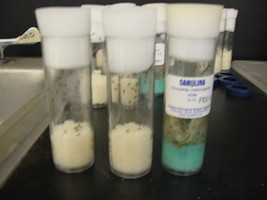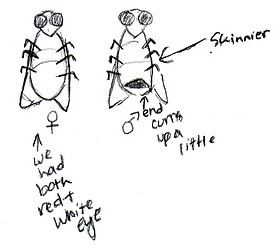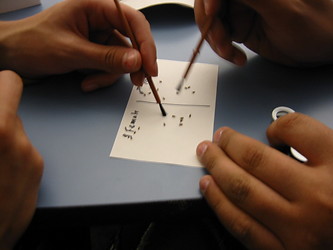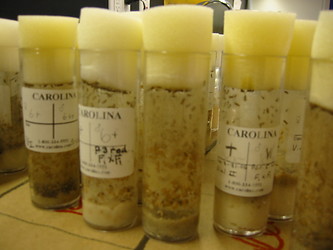Introduction
The purpose of our fruit fly experiment was to learn about genetics which is the study of DNA, genes and traits. We also studied mutations, which are the changing of an organism's genes and DNA sequence which makes the organism different than that of its species, and the effects of it on our flies. The reason we used fruit flies is because they are easily cultured and only live for about two weeks. They take up only a small space and females lay about 500 eggs in 10 days. This gives lots of data and multiple generations in a short period of time. Also, the mutations are quickly evident because of easy to see phenotypes.
Characteristics
KINGDOM: Animalia- This phylum contains a variety of bilaterally symmetrical coelmats, including lobsters, crabs, spiders and insects. These animals have adapted to almost every environment on earth.
CLASS: Insecta
- 3 tagmata- head thorax and abdomen
- mandibles
- one pair of antennae
- two or more pairs of wings
- three pairs of jointed legs
ORDER: Diptera
- one pair of wings
- sucking, piercing, or lapping mouth (carries disease, destroys crops, pollinate flowers, decomposes)
FAMILY: not sure
GENUS: Drosophila
SPECIES: Melanogaster
Phenotypes
Phenotypes are an organism's appearance or other detectable characteristic that results from the organism's genotype and the environment. Phenotype is either a total physical appearance and constitution or a specific manifestation of a trait just like size or eye color that could vary between individuals. Phenotypes are determined by genotype or by the identity of the alleles that an individual carries at one or more positions on the chromosomes. For example, If a fruit fly has red eyes and other normal characteristics it's phenotype is wild type. A common phenotype mutation in fruit flys is vestigal wings, which are designated by the genotype vg. A lot of phenotypes are determined by multiple genes and influenced by environmental factors. The identity of one or a few known alleles does not always enable prediction of the phenotype. Phenotypes are much easier to observe than genotypes. Therefore, classical genetics use phenotypes to deduce the functions of genes. Breeding experiments can also be checked as references. Geneticists then discovered that they were able to trace inheritance patterns without any knowledge of molecular biology.
P1 cross life cycle log
3/16 V1- No larva, no dead flies
V2- No larva, no dead flies
3/17 V1- No larva, no dead flies, no changes
V2- Flies don't appear to be dead, but they have burrowed out of the medium and are moving very slowly inside the ditches they dug.
3/20 V1- Larva visible,no dead flies, burrows visible.
V2-Larva visible, one possibly dead fly. Burrows visible.
3/21 V1- More larva visible on the sides of the vial. Pupas also visible. No dead flies.
V2- More larva visible, no dead flies
3/23 V1- Lots of pupas and larvae
V2- many pupa and larvae
3 /24 V1- Adult flies have been removed, tons of pupa, fewer larva, none ready to hatch.
V2- adults removed, tons of pupas and larva, none ready o hatch.
3/27 V1- Pupas have hatched, mostly wild type flies fill the vial.
V2- pupas have hatched, still several remain, and there is plenty of larvae
3/28 V1- There are even more flies and there are still several pupa. the pupa are getting darker and will soon emerge.
V2- several flies and pupa
3/30 V1 many flies, several pupa, some larva
V2- tons of flies, several pupa, some larva. some dark pupa.

Sexing the flies
- First we napped the flies, with the Fly Nap (and waited about two minutes)
- Then when all the flies were anesthetized, we opened the vial and dumped the flies out on our male/female note cards.
- Then we used a small paintbrush to separate male from female.
- You can identify sexes simply by their appearance. Females are much larger, and the males are skinnier and have a black tip on their abdomen. (see drawing below)
- After the flies had been sorted by sex, and while the flies were still anesthetized we disposed of them in our Fly Morgue, which was a vat of rubbing alcohol.


Drosophila melanogaster. Fruit fly vials. © 2006
F1 Cross Predictions
We did a number of various test crosses to determine approximately how our F1 generation would turn out. We tested Autosomal crosses to see the differences between dominant and recessive, and different possible sex linked crosses. Here are some examples:
vg= Vestigial Wings += Wild type
Autosomal Hypothesis 1(Vg Dominant):
| vg | vg | |
| + | +vg | +vg |
| + | +vg | +vg |
100% of the offspring will be vestigial and heterozygous.
Sex-Linked Hypothesis 1 (+ Dominant & Sex-linked):
| X+ | Y | |
| Xvg | XvgX+ | XvgY |
| Xvg | XvgX+ | XvgY |
50% Wild, Heterozygous female 50% Vestigial Male
F1 outcomes
- In vial 1 the male phenotype was Vestigial winged and Wild.
- In vial 1 the female phenotype also was both Vestigial winged and Wild.
- In vial 2 the male phenotype was all wild.
- In vial 2 the female phenotype was also all wild.
F2 Cross Predictions
Our predictions for the F2 fly cross revolved around the hypothesis that the vestigial wing mutation is autosomal recessive. We concluded this by observing that the likely genotype for F1 offspring was +vg. Meaning that the offspring were heterozygous wild in both sexes. Here are some example punnet squares of our F2 predictions.
+= Wild winged vg= Vestigial winged
Vial 1
| vg | + | |
| + | +vg | ++ |
| vg | vgvg | vg+ |
Phenotypes for F2 Offspring: Genotypes for F2 Offspring:
75% Wild 25% Vestigial 50% heterozygous + 25% Homozygous vg Recess.
25% Homozygous + Dominant
Vial 2
| + | vg | |
| vg | vg+ | vgvg |
| + | ++ | +vg |
Phenotypes for F2 Offspring: Genotypes for F2 Offspring:
75% Wild 25% Vestigial 50% Heterozygous + 25% Homozygous vg Recess.
25% Homozygous + Dominant
F2 Final Count
vial 1
Overall Total 278 | Total Wild 252 | Total Vestigial 26 |
Vial 2
Overall Total 183 | Total Wild 147 | Total Vestigial 36 |
Percent Error
Vial 1
| Wild | 252 | 208.5 | 43.5 | .208 | 20.8 | 20.8% |
| Vestigial | 26 | 69.5 | 43.5 | .625 | 62.59 | 62.5% |
Vial 2
| Wild | 147 | 137 | 10 | .07 | 7 | 7% |
| Vestigial | 36 | 40 | 10 | .22 | 22 | 22% |
Conclusion
In the parent generation, the mutation vestigial is autosomal recessive, with a phenotype ratio of 3:1. Our results show a successful experiment. We had a very low percent error despite all the factors that could have resulted in poor numbers. For example, it was evident that we had contamination in vial one because we had flies with vestigal wings even though it was the F1 cross between wild type flies and heterozygous vestigal flies, which should have produced all wild type. In the end, this did not matter and the results still showed a low percent error. If we were to repeat this experiment, one thing we might try to do is monitor the parent crosses more closely to make sure we don't get any contamination of chromosomes. Still, in Vial one we only showed a 21% error with the wild type and a larger 63% error with the vestigal (208:70 vs. 252:26 as predicted). And in vial two, the wild type showed only a 7% error and the vestigial showed a 22% error.
Eulogy/Epitaph
Though their lives were short, I'm sure we will all envy the simple bliss that was being a fly. To live in a world where your only obligation is to fly around and mate.






 Go to quick links
Go to quick search
Go to navigation for this section of the ToL site
Go to detailed links for the ToL site
Go to quick links
Go to quick search
Go to navigation for this section of the ToL site
Go to detailed links for the ToL site